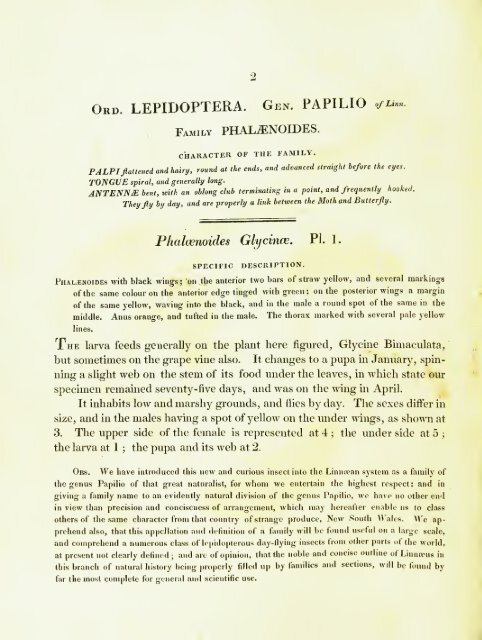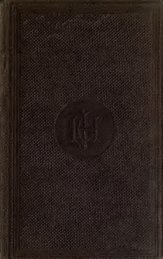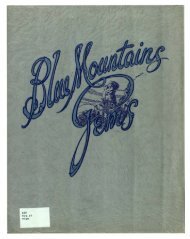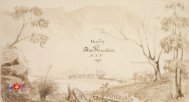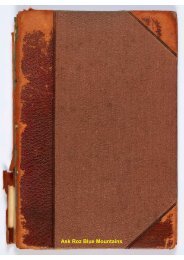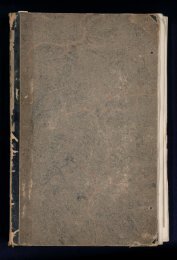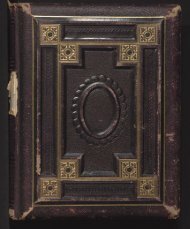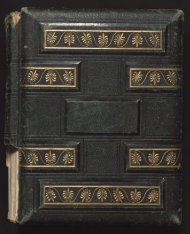A Natural History of Lepidopterous of NSW by John William Lewin
A Natural History of Lepidopterous of NSW by John William Lewin COLLECTED, ENGRAVED, AND FAITHFULLY PAINTED AFTER NATURE JOHN WILLIAM LEWIN, A.L.S. LATE OF PARAMATTA, NEW SOUTH WALES
A Natural History of Lepidopterous of NSW by John William Lewin
COLLECTED, ENGRAVED, AND FAITHFULLY PAINTED AFTER NATURE
JOHN WILLIAM LEWIN, A.L.S. LATE OF PARAMATTA, NEW SOUTH WALES
You also want an ePaper? Increase the reach of your titles
YUMPU automatically turns print PDFs into web optimized ePapers that Google loves.
Ord. LEPIDOPTERA. Gen. PAPILIO o/Linn.<br />
Family<br />
PHAL^NOIDES.<br />
CHARACTER OF THE FAMILY.<br />
PALPIflattened and hairy, round at the ends, and advanced straight before the eyes.<br />
TONGUE spiral, and generally long.<br />
ANTENNM bent, with, an oblong club terminating in a point, and frequently hooked.<br />
They fly <strong>by</strong> day, and are properly a link between the Moth and Butterfly.<br />
Phalcenoides Glycinas. PI. 1.<br />
SPECIFIC DESCRIPTION.<br />
Phalcenoides with black wings ; on the anterior two bars <strong>of</strong> straw yellow, and several markings<br />
<strong>of</strong> the same colour on the anterior edge tinged with green : on the posterior wings a margin<br />
<strong>of</strong> the same yellow, waving into the black, and in the male a round spot <strong>of</strong> the same in the<br />
middle. Anus orange, and tufted in the male. The thorax marked with several pale yellow<br />
lines.<br />
The larva feeds generally on the plant here figured, Glycine Bimaculata,<br />
but sometimes on the grape vine also. It changes to a pupa in January, spinning<br />
a slight web on the stem <strong>of</strong> its food under the leaves, in which state our<br />
specimen remained seventy-five days, and was on the wing in April.<br />
It inhabits low and marshy grounds, and flies <strong>by</strong> day. The sexes differ in<br />
size, and in the males having a spot <strong>of</strong> yellow on the under wings, as shown at<br />
3. The upper side <strong>of</strong> the female is represented at 4 ; the under side at 5 ;<br />
the larva at 1 ; the pupa and its web at 2.<br />
Obs. We have introduced this new and curious insect into the Linneean system as a family <strong>of</strong><br />
the genus Papilio <strong>of</strong> that great naturalist, for whom we entertain the highest respect: and in<br />
giving a family name to an evidently natural division <strong>of</strong> the genus Papilio, we have no other end<br />
in view than precision and conciseness <strong>of</strong> arrangement, which may hereafter enable us to class<br />
others <strong>of</strong> the same character from that country <strong>of</strong> strange produce, New South Wales. We apprehend<br />
also, that this appellation and definition <strong>of</strong> a family will be found useful on a large scale.<br />
and comprehend a numerous class <strong>of</strong> lepidopterous day-flying- insects from other parts <strong>of</strong> the world,<br />
at present not clearly defined ;<br />
and are <strong>of</strong> opinion, that the noble and concise outline <strong>of</strong> Linnaeus in<br />
this branch <strong>of</strong> natural history being properly filled up <strong>by</strong> families and sections, will be found <strong>by</strong>far<br />
the most complete for general and scientific use.


